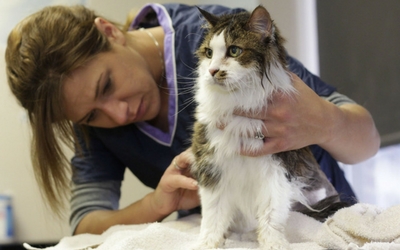
August 22nd is Bring your Cat to the Vet Day. It is the perfect opportunity to schedule your cat’s routine veterinary check-up and think about any health-related red flags or issues you may have noticed recently in your cat. Providing good health and wellness care for your feline friends can help them live longer, healthier lives.
Many cats do not receive the level of veterinary care they should, generally because they don’t visit the vet often enough. Routine, preventive care is very important even for healthy cats, and regular vet visits are an important part of your pet’s health care, for a few reasons:
- Cats age at a much quicker rate than humans do, so they should be seen by their veterinarian more often than we as people see our doctors. Cats mature very quickly during their first two years of life, generally thought to equate to about 25 human years. After that, one human year is about 4 feline years, so a 5-year-old cat is about 37 years old, and a 10-year-old cat is about 57
- Cats are also very good at hiding illnesses and pain. While you, their owner may not notice something wrong, veterinarians are trained to spot potential issues before they become difficult to treat. You may not notice a gradual shift in your pet’s behavior until asked specific, pointed questions.
- Over 50% of cats are overweight or obese, which puts your cat at risk for many conditions including diabetes, heart disease, and more.
- Preventive care is far preferable to reactive care: it is much better to detect problems early and avoid emergency situations than to have to deal with them once they’ve become an issue. Early detection means treatments are often more successful and less costly.
Cats should have a complete veterinary examination at least once a year, although some cats should be seen more often, depending on individual needs and health concerns. The visit should include a review of your cat’s recent history, lifestyle, life stage, activities of daily living, general behavior, and diet. The physical examination itself should include a dental assessment, pain assessment, and body condition scoring. It may also including testing, such as blood tests for heartworm and organ malfunction along with urinalysis, a stool sample to test for intestinal parasites, and screening tests for Feline Immunodeficiency Virus and Feline Leukemia, as a means of getting a complete picture of your cat’s health. You may need to have your cat’s immunizations brought up to date, and discuss or review ongoing parasite preventions. Any diagnoses for medical issues will be made after all the information has been gathered and examination made. Your vet will also likely discuss a preventive healthcare plan for your cat for the future, to maintain her optimum health.
Vet visits don’t have to be scary or stressful—for either of you. Here are some tips for reducing the stress of vet visits for both of you:
- Understand why your cat gets stressed out. The carrier, car ride, and vet’s office are all unfamiliar places with new sights, sounds, smells and people. Give them a chance to become familiar with the car and carrier well in advance of the vet visit, to help reduce the stress they can cause.
- Make the carrier familiar by leaving it out and accessible for your cat well in advance of the vet visit. Place familiar bedding, toys, and treats in it, and encourage your cat to check it out, although it may take some time before she goes in voluntarily.
- Make sure your vet’s office is a Cat Friendly Practice or find one that is; they will be trained in feline-friendly handling and understanding feline-specific behaviors to increase the quality of care for your cat, as well as providing a more calming environment for you and your cat.
Visits to the vet can be a positive, pleasant experience for you both. Because they are necessary and important, it is important to try to make going to the vet at the very least, an event your cat doesn’t mind, rather than one filled with fear and anxiety. For more information, visit http://www.catvets.com/Cat2VetDay
